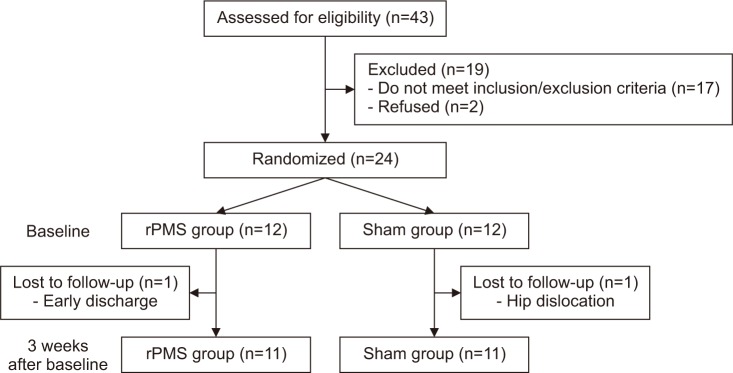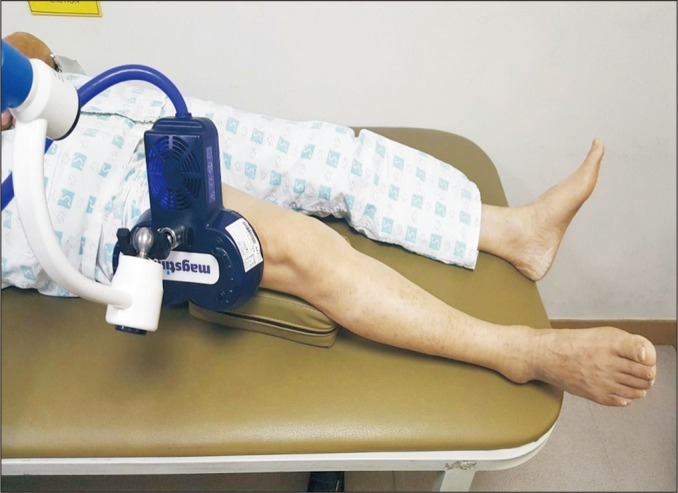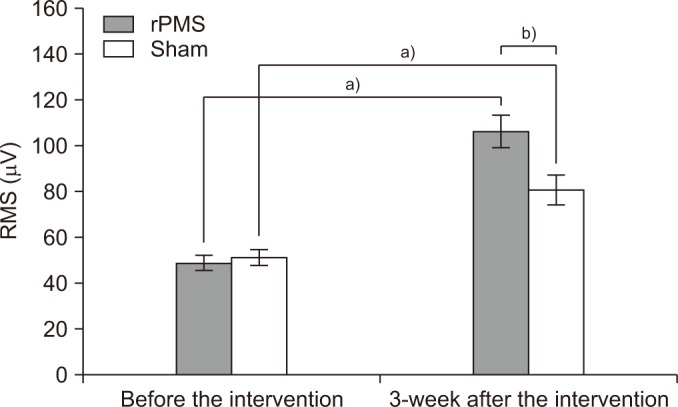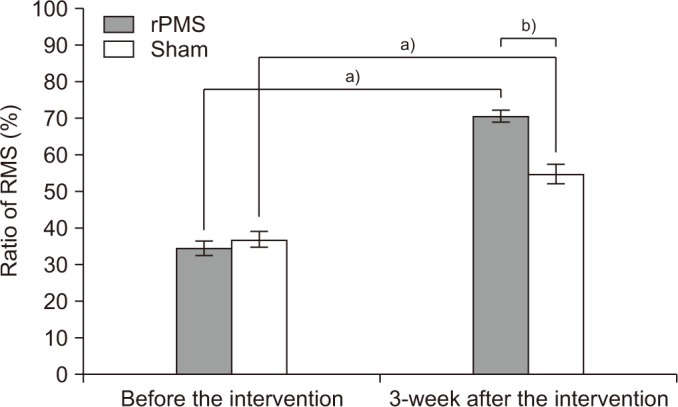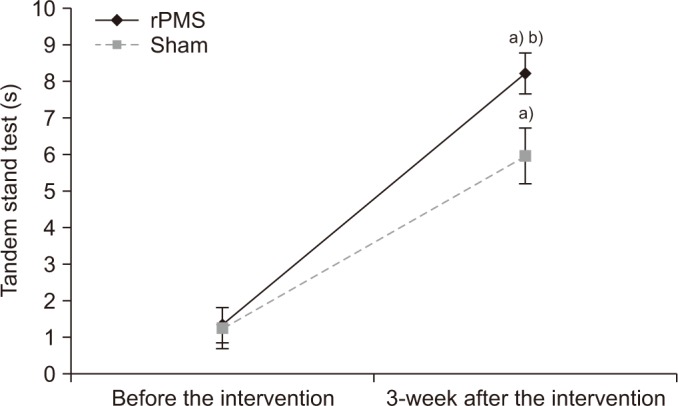Ann Rehabil Med.
2018 Feb;42(1):67-75. 10.5535/arm.2018.42.1.67.
Effects of Repetitive Peripheral Magnetic Stimulation Over Vastus Lateralis in Patients After Hip Replacement Surgery
- Affiliations
-
- 1Department of Physical Medicine and Rehabilitation, Sun General Hospital, Daejeon, Korea. rmactksk@daum.net
- 2Department of Orthopedic Surgery, Sun General Hospital, Daejeon, Korea.
- 3Department of Physical Medicine and Rehabilitation, Chungnam National University Hospital, Daejeon, Korea.
- KMID: 2440971
- DOI: http://doi.org/10.5535/arm.2018.42.1.67
Abstract
OBJECTIVE
To investigate the effects of repetitive peripheral magnetic stimulation (rPMS) on the vastus lateralis (VL) in the early stage after hip replacement surgery.
METHODS
Twenty-two patients who underwent hip replacement after proximal femur fracture were included in this study. After hip surgery, the experimental group was applied with 15 sessions of 10 Hz rPMS over the VL 5 times per week for 3 weeks, while the control group took sham stimulation. All patients were also given conventional physical therapy. The VL strength was measured with the root mean square (RMS) value of the VL with surface electromyography technique. The ratio of RMS values between fractured and unfractured legs and tandem stand test were used to assess standing balance. Usual gait speed was measured to evaluate gait function. Pain in two groups was assessed with visual analog scale (VAS).
RESULTS
Both RMS value of the VL and the ratio of RMS values after rPMS were significantly improved (p < 0.05). Also, tandem standing time and usual gait speed in rPMS group were dramatically increased (p < 0.05). However, no significant difference in VAS was found between the two groups after 3 weeks.
CONCLUSION
rPMS on the VL improved muscle strength, standing balance and gait function in the early stage after hip surgery. Therefore, rPMS could be applied to patients who cannot take electrical stimulation due to pain and an unhealed wound.
Keyword
MeSH Terms
Figure
Reference
-
1. Kannus P, Parkkari J. Prevention of hip fracture with hip protectors. Age Ageing. 2006; 35(Suppl 2):ii51–ii54. PMID: 16926206.
Article2. Peeters CM, Visser E, Van de Ree CL, Gosens T, Den Oudsten BL, De Vries J. Quality of life after hip fracture in the elderly: a systematic literature review. Injury. 2016; 47:1369–1382. PMID: 27178770.
Article3. Kim JL, Jung JS, Kim SJ. Prediction of ambulatory status after hip fracture surgery in patients over 60 years old. Ann Rehabil Med. 2016; 40:666–674. PMID: 27606273.
Article4. Mitchell SL, Stott DJ, Martin BJ, Grant SJ. Randomized controlled trial of quadriceps training after proximal femoral fracture. Clin Rehabil. 2001; 15:282–290. PMID: 11386398.
Article5. Aniansson A, Zetterberg C, Hedberg M, Henriksson KG. Impaired muscle function with aging. A background factor in the incidence of fractures of the proximal end of the femur. Clin Orthop Relat Res. 1984; (191):193–201.
Article6. Lamb SE, Morse RE, Evans JG. Mobility after proximal femoral fracture: the relevance of leg extensor power, postural sway and other factors. Age Ageing. 1995; 24:308–314. PMID: 7484488.
Article7. Lee YH. Functional electrical stimulation. J Korean Acad Rehabil Med. 2001; 25:1–11.8. Chipchase LS, Schabrun SM, Hodges PW. Peripheral electrical stimulation to induce cortical plasticity: a systematic review of stimulus parameters. Clin Neurophysiol. 2011; 122:456–463. PMID: 20739217.
Article9. Schuhfried O, Crevenna R, Fialka-Moser V, Paternostro-Sluga T. Non-invasive neuromuscular electrical stimulation in patients with central nervous system lesions: an educational review. J Rehabil Med. 2012; 44:99–105. PMID: 22334346.
Article10. Braid V, Barber M, Mitchell SL, Martin BJ, Granat M, Stott DJ. Randomised controlled trial of electrical stimulation of the quadriceps after proximal femoral fracture. Aging Clin Exp Res. 2008; 20:62–66. PMID: 18283230.
Article11. Struppler A, Angerer B, Havel P. Modulation of sensorimotor performances and cognition abilities induced by RPMS: clinical and experimental investigations. Suppl Clin Neurophysiol. 2003; 56:358–367. PMID: 14677412.12. Machetanz J, Bischoff C, Pichlmeier R, Riescher H, Meyer BU, Sader A, et al. Magnetically induced muscle contraction is caused by motor nerve stimulation and not by direct muscle activation. Muscle Nerve. 1994; 17:1170–1175. PMID: 7935524.
Article13. Zhu Y, Starr A. Magnetic stimulation of muscle evokes cerebral potentials. Muscle Nerve. 1991; 14:721–732. PMID: 1890997.
Article14. Zhu Y, Starr A, Haldeman S, Fu H, Liu J, Wu P. Magnetic stimulation of muscle evokes cerebral potentials by direct activation of nerve afferents: a study during muscle paralysis. Muscle Nerve. 1996; 19:1570–1575. PMID: 8941271.
Article15. Struppler A, Binkofski F, Angerer B, Bernhardt M, Spiegel S, Drzezga A, et al. A fronto-parietal network is mediating improvement of motor function related to repetitive peripheral magnetic stimulation: a PET-H2O15 study. Neuroimage. 2007; 36(Suppl 2):T174–T186. PMID: 17499165.
Article16. Gallasch E, Christova M, Kunz A, Rafolt D, Golaszewski S. Modulation of sensorimotor cortex by repetitive peripheral magnetic stimulation. Front Hum Neurosci. 2015; 9:407. PMID: 26236220.
Article17. Han TR, Shin HI, Kim IS. Magnetic stimulation of the quadriceps femoris muscle: comparison of pain with electrical stimulation. Am J Phys Med Rehabil. 2006; 85:593–599. PMID: 16788390.18. Barker AT, Freeston IL, Jalinous R, Jarratt JA. Magnetic stimulation of the human brain and peripheral nervous system: an introduction and the results of an initial clinical evaluation. Neurosurgery. 1987; 20:100–109. PMID: 3808249.19. Szecsi J, Schiller M, Straube A, Gerling D. A comparison of functional electrical and magnetic stimulation for propelled cycling of paretic patients. Arch Phys Med Rehabil. 2009; 90:564–570. PMID: 19345770.
Article20. Amassian VE, Maccabee PJ, Cracco RQ. Focal stimulation of human peripheral nerve with the magnetic coil: a comparison with electrical stimulation. Exp Neurol. 1989; 103:282–289. PMID: 2920794.
Article21. Bustamante V, Lopez de Santa Maria E, Gorostiza A, Jimenez U, Galdiz JB. Muscle training with repetitive magnetic stimulation of the quadriceps in severe COPD patients. Respir Med. 2010; 104:237–245. PMID: 19896353.
Article22. Pujol J, Pascual-Leone A, Dolz C, Delgado E, Dolz JL, Aldoma J. The effect of repetitive magnetic stimulation on localized musculoskeletal pain. Neuroreport. 1998; 9:1745–1748. PMID: 9665594.
Article23. Alkner BA, Tesch PA, Berg HE. Quadriceps EMG/force relationship in knee extension and leg press. Med Sci Sports Exerc. 2000; 32:459–463. PMID: 10694132.
Article24. Guralnik JM, Simonsick EM, Ferrucci L, Glynn RJ, Berkman LF, Blazer DG, et al. A short physical performance battery assessing lower extremity function: association with self-reported disability and prediction of mortality and nursing home admission. J Gerontol. 1994; 49:M85–M94. PMID: 8126356.
Article25. Guralnik JM, Ferrucci L. Assessing the building blocks of function: utilizing measures of functional limitation. Am J Prev Med. 2003; 25(3 Suppl 2):112–121.26. Lamb SE, Oldham JA, Morse RE, Evans JG. Neuro muscular stimulation of the quadriceps muscle after hip fracture: a randomized controlled trial. Arch Phys Med Rehabil. 2002; 83:1087–1092. PMID: 12161829.27. Fukuda TY, Echeimberg JO, Pompeu JE, Lucareli PR, Garbelotti S, Gimenes RO, et al. Root mean square value of the electromyographic signal in the isometric torque of the quadriceps, hamstrings and brachial biceps muscles in female subjects. J Appl Res. 2010; 10:32–39.28. Ferrucci L, Guralnik JM, Buchner D, Kasper J, Lamb SE, Simonsick EM, et al. Departures from linearity in the relationship between measures of muscular strength and physical performance of the lower extremities: the Women's Health and Aging Study. J Gerontol A Biol Sci Med Sci. 1997; 52:M275–M285. PMID: 9310081.
Article
- Full Text Links
- Actions
-
Cited
- CITED
-
- Close
- Share
- Similar articles
-
- Preferential Vastus Medialis Oblique Activation Achieved by Isokinetic Cycling at High Angular Velocity
- Comparisons of Vastus Medialis and Vastus Lateralis Muscle Activities according to Different Heights during Drop Landing in Flatfooted Adults
- Morphometric study of tensor of vastus intermedius in South Indian population
- Pedicle and Skin Territory of the Vastus Lateralis Muscle for the Anterolateral Thigh Free Flap
- Comparison between the Electric and Magnetic Stimulations for a Repetitive Nerve Stimulation Test

